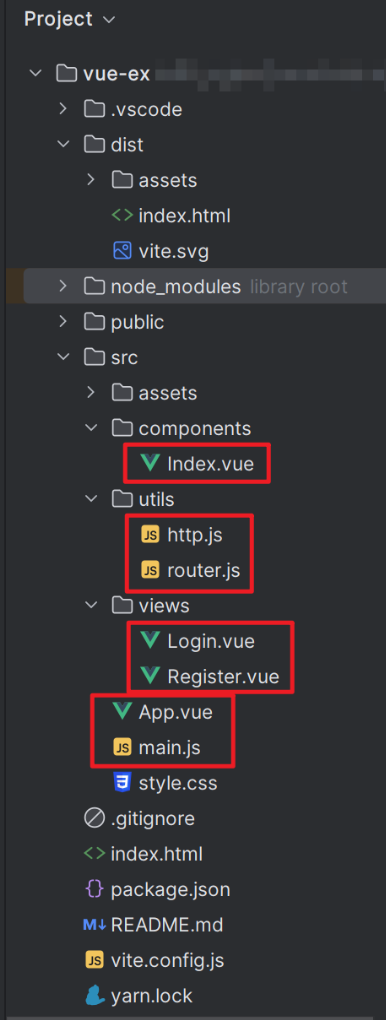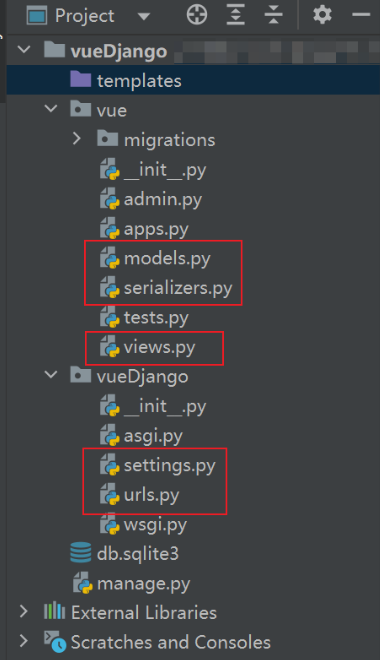博客地址:https://www.cnblogs.com/zylyehuo/
一、使用 vite+webstorm 搭建 Vue 环境,构建前端
1、结构树
2、main.js
import { createApp } from 'vue'
//import './style.css'
import App from './App.vue'
import router from "./utils/router";
createApp(App).use(router).mount('#app')
3、http.js
import axios from "axios"; // 要导入安装的包,则直接填写包名即可。不需要使用路径
// 实例化
const http = axios.create({
//baseURL: 'http://wthrcdn.etouch.cn/', // 请求的公共路径,一般填写服务端的默认的api地址,这个地址在具体使用的时候覆盖
baseURL: 'http://127.0.0.1:8000/vue/', // 请求的公共路径,一般填写服务端的默认的api地址,这个地址在具体使用的时候覆盖
timeout: 8000, // 最大请求超时时间,请求超过这个时间则报错,有文件上传的站点不要设置这个参数
//headers: {'X-Custom-Header': 'foobar'} // 默认的预定义请求头,一般工作中这里填写隐藏了客户端身份的字段
});
export default http;
4、router.js
import {createRouter, createWebHistory} from 'vue-router';
import Login from "../views/Login.vue";
import Register from "../views/Register.vue";
import Index from "../components/Index.vue";
const router = createRouter({
history: createWebHistory(),
routes: [
{
path: "/",
name: "myLogin",
component: Login,
},
{
path: "/login",
name: "Login",
component: Login,
},
{
path: "/reg",
name: "Register",
component: Register,
},
{
path: "/index",
name: "Index",
component: Index,
},
]
})
export default router;
5、App.vue
<script>
</script>
<template>
<router-view></router-view>
</template>
<style scoped>
</style>
6、Index.vue
<template>
<button><router-link to="/reg">register</router-link></button>
<button><router-link to="/login">login</router-link></button>
<h3 @click="log">{{ message }}</h3>
<span>{{ login_message }}</span>
</template>
<!-- 以下为选项API格式 -->
<script>
export default {
name: "Index",
data() {
return {
message: "welcome to INDEX",
login_message: '登录成功!!!',
}
},
methods: {
log() {
console.log(this.message)
},
},
}
</script>
<style scoped>
</style>
7、Register.vue
<template>
<hr>
<h1>注册页面</h1>
<hr>
用户账号:<input type="text" v-model="username"><span>{{ info1 }}</span><br>
设置密码:<input :type="password1" v-model="passwd1">
<button @click="pwd1">{{ tip1 }}</button>
<span>{{ info2 }}</span><br>
确认密码:<input :type="password2" v-model="passwd2">
<button @click="pwd2">{{ tip2 }}</button>
<span>{{ info2 }}</span><br>
<button><a href="/login" @click.prevent="send_post">register</a></button>
<button>
<router-link to="/login">login</router-link>
</button>
</template>
<script>
import http from "../utils/http.js";
export default {
name: "Register",
data() {
return {
username: '请输入用户名',
passwd1: '请输入密码',
passwd2: '请确认密码',
password1: 'password',
password2: 'password',
tip1: '显示密码',
tip2: '显示密码',
num1: 0,
num2: 0,
info1: '',
info2: ''
}
},
methods: {
pwd1() {
if (this.num1 === 0) {
this.password1 = 'text'
this.tip1 = '隐藏密码'
this.num1 = 1
} else {
this.password1 = 'password'
this.tip1 = '显示密码'
this.num1 = 0
}
},
pwd2() {
if (this.num2 === 0) {
this.password2 = 'text'
this.tip2 = '隐藏密码'
this.num2 = 1
} else {
this.password2 = 'password'
this.tip2 = '显示密码'
this.num2 = 0
}
},
send_post() {
http.post("http://127.0.0.1:8000/vue/", {
username: this.username,
passwd: this.passwd1,
passwd2: this.passwd2,
},
).then(response => {
//console.log(response.data); // 服务端响应的响应体
if (response.data.state == 'fail1') {
//console.log('注册失败')
this.info1 = response.data.tip
this.info2 = ''
} else if (response.data.state == 'fail2') {
this.info1 = ''
this.info2 = response.data.tip
} else {
window.location.href = "/login"
}
}).catch(error => {
console.log('请求错误!error=', error)
})
},
}
}
</script>
<style scoped>
* {
margin: 10px;
}
span {
color: red;
}
</style>
8、Login.vue
<template>
<hr>
<h1>登录页面</h1>
<hr>
账号:<input type="text" v-model="username"><span>{{ info3 }}</span><br>
密码:<input :type="password" v-model="passwd">
<button @click="pwd">{{ tip }}</button>
<span>{{ info4 }}</span>
<br>
<button>
<a href="/" @click.prevent="send_post">login</a>
</button>
<button>
<router-link to="/reg">register</router-link>
</button>
</template>
<script>
import http from "../utils/http.js";
export default {
name: "Login",
data() {
return {
username: '请输入用户名',
passwd: '请输入密码',
password: 'password',
tip: '显示密码',
num: 0,
info3: '',
info4: '',
}
},
methods: {
pwd() {
if (this.num === 0) {
this.password = 'text'
this.tip = '隐藏密码'
this.num = 1
} else {
this.password = 'password'
this.tip = '显示密码'
this.num = 0
}
},
send_post() {
http.post("http://127.0.0.1:8000/vue/", {
username: this.username,
passwd: this.passwd,
},
).then(response => {
//console.log(response.data); // 服务端响应的响应体
if (response.data.state == 'fail3') {
//console.log('注册失败')
this.info3 = ''
this.info4 = response.data.tip
} else if (response.data.state == 'fail4') {
this.info3 = response.data.tip
this.info4 = ''
} else {
window.location.href = "/index"
}
}).catch(error => {
console.log('请求错误!error=', error)
})
},
}
}
</script>
<style scoped>
* {
margin: 10px;
}
span {
color: red;
}
</style>
二、使用 pycharm 搭建 Django 环境,构建后端
1、结构树
2、settings.py
"""
Django settings for vueDjango project.
Generated by 'django-admin startproject' using Django 3.2.
For more information on this file, see
https://docs.djangoproject.com/en/3.2/topics/settings/
For the full list of settings and their values, see
https://docs.djangoproject.com/en/3.2/ref/settings/
"""
import os
from pathlib import Path
# Build paths inside the project like this: BASE_DIR / 'subdir'.
BASE_DIR = Path(__file__).resolve().parent.parent
# Quick-start development settings - unsuitable for production
# See https://docs.djangoproject.com/en/3.2/howto/deployment/checklist/
# SECURITY WARNING: keep the secret key used in production secret!
SECRET_KEY = 'django-insecure-q!0%lzaj1csl*(6olo+!h=7de5&*@tf_@r@2+=br_nvmzsump='
# SECURITY WARNING: don't run with debug turned on in production!
DEBUG = True
ALLOWED_HOSTS = []
# Application definition
INSTALLED_APPS = [
'django.contrib.admin',
'django.contrib.auth',
'django.contrib.contenttypes',
'django.contrib.sessions',
'django.contrib.messages',
'django.contrib.staticfiles',
'rest_framework',
'corsheaders',
'vue.apps.VueConfig',
]
MIDDLEWARE = [
'django.middleware.security.SecurityMiddleware',
'django.contrib.sessions.middleware.SessionMiddleware',
'corsheaders.middleware.CorsMiddleware',
'django.middleware.common.CommonMiddleware',
# 'django.middleware.csrf.CsrfViewMiddleware',
'django.contrib.auth.middleware.AuthenticationMiddleware',
'django.contrib.messages.middleware.MessageMiddleware',
'django.middleware.clickjacking.XFrameOptionsMiddleware',
]
ROOT_URLCONF = 'vueDjango.urls'
CORS_ORIGIN_ALLOW_ALL = True
TEMPLATES = [
{
'BACKEND': 'django.template.backends.django.DjangoTemplates',
'DIRS': [BASE_DIR / 'templates']
,
'APP_DIRS': True,
'OPTIONS': {
'context_processors': [
'django.template.context_processors.debug',
'django.template.context_processors.request',
'django.contrib.auth.context_processors.auth',
'django.contrib.messages.context_processors.messages',
],
},
},
]
WSGI_APPLICATION = 'vueDjango.wsgi.application'
# Database
# https://docs.djangoproject.com/en/3.2/ref/settings/#databases
DATABASES = {
'default': {
'ENGINE': 'django.db.backends.sqlite3',
'NAME': BASE_DIR / 'db.sqlite3',
}
}
# Password validation
# https://docs.djangoproject.com/en/3.2/ref/settings/#auth-password-validators
AUTH_PASSWORD_VALIDATORS = [
{
'NAME': 'django.contrib.auth.password_validation.UserAttributeSimilarityValidator',
},
{
'NAME': 'django.contrib.auth.password_validation.MinimumLengthValidator',
},
{
'NAME': 'django.contrib.auth.password_validation.CommonPasswordValidator',
},
{
'NAME': 'django.contrib.auth.password_validation.NumericPasswordValidator',
},
]
# Internationalization
# https://docs.djangoproject.com/en/3.2/topics/i18n/
LANGUAGE_CODE = 'en-us'
TIME_ZONE = 'UTC'
USE_I18N = True
USE_L10N = True
USE_TZ = True
# Static files (CSS, JavaScript, Images)
# https://docs.djangoproject.com/en/3.2/howto/static-files/
STATIC_URL = '/static/'
# Default primary key field type
# https://docs.djangoproject.com/en/3.2/ref/settings/#default-auto-field
DEFAULT_AUTO_FIELD = 'django.db.models.BigAutoField'
3、urls.py
from django.urls import path
from vue import views
urlpatterns = [
path('vue/', views.VueViews.as_view()),
]
4、models.py
from django.db import models
# Create your models here.
class User(models.Model):
"""学生信息"""
username = models.CharField(max_length=32, verbose_name="用户名")
passwd = models.CharField(max_length=32, verbose_name="密码")
class Meta:
db_table = "tb_user"
def __str__(self):
return str(self.username)
5、serializers.py
from rest_framework import serializers
from vue.models import User
class UserModelSerializer(serializers.ModelSerializer):
class Meta:
model = User
fields = "__all__"
6、views.py
from django.shortcuts import render, HttpResponse, redirect
# Create your views here.
from rest_framework import status
from rest_framework.views import APIView
from .serializers import UserModelSerializer, User
from rest_framework.response import Response
import json
class VueViews(APIView):
def get(self, request):
"""获取所有用户信息"""
# 1. 从数据库中读取用户列表信息
instance_list = User.objects.all()
# 2. 实例化序列化器,获取序列化对象
serializer = UserModelSerializer(instance_list, many=True)
# 3. 使用serializer.data实现对数据进行序列化成字典
return Response(serializer.data)
def post(self, request):
"""添加用户信息"""
# 1. 获取客户端提交的数据,实例化序列化器,获取序列化对象
serializer = UserModelSerializer(data=request.data)
# 2. 反序列化[验证数据、保存数据到数据库]
serializer.is_valid(raise_exception=True)
username = request.data['username']
passwd = request.data['passwd']
if request.data.get('passwd2', ''):
userinfo = User.objects.filter(username=username)
if userinfo.exists():
# print('用户已存在')
info = {"state": "fail1", "tip": '用户已存在'}
return HttpResponse(json.dumps(info))
else:
passwd2 = request.data['passwd2']
if passwd2 != passwd:
# print('两次密码输入不同,请重新输入')
info = {"state": "fail2", "tip": '两次密码输入不同,请重新输入'}
return HttpResponse(json.dumps(info))
else:
serializer.save()
# print('注册成功')
# print(username, passwd, passwd2)
else:
userinfo = User.objects.filter(username=username)
if userinfo.exists():
if User.objects.get(username=username).passwd == passwd:
# print('登录成功')
pass
else:
# print('密码错误,请重新输入')
info = {"state": "fail3", "tip": '密码错误,请重新输入'}
return HttpResponse(json.dumps(info))
else:
# print('用户名不存在,请重新输入')
info = {"state": "fail4", "tip": '用户名不存在,请重新输入'}
return HttpResponse(json.dumps(info))
# print(username, passwd)
# 3. 返回新增的模型数据经过序列化提供给客户端
return Response(serializer.data, status=status.HTTP_201_CREATED)




